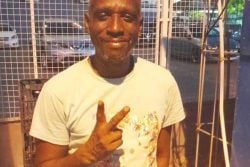It was just another Sunday in the South American cocaine belt when the Guyana Defence Force discovered another illegal airstrip by chance. All the telltale traces that this was another episode in the series of airborne narco-trafficking cases were evident.
Located 130 km upriver from Orealla on the Corentyne River, the illegal airstrip was an impressive 1,100 m long and 35 m wide. The Let 410 UVP-E turboprop aeroplane, which was found partially burnt on the illegal strip has a payload of 1,615 kg and a range of over 1,300 km. That’s a lot of cocaine per flight!
The public is fed up with this and similar reports over the past twenty years which lead nowhere. In February 1989, for example, a 1,200 m illegal airstrip was ‘discovered’ within the defence force’s training area at Tacama. Three Colombians were arrested and ammunition, weapons, water pumps electrical generators transmitting sets and aircraft engines were found.
A low-flying aircraft dropped 20 cartons of cocaine at Loo Lands, on the Demerara River, in June 1993. There were more arrests. A burnt-out aircraft was ‘discovered’ on the airstrip at Bartica in December 1998. Another burnt-out aircraft was ‘discovered’ at Mabura Hill in July 2000. An abandoned aircraft was ‘discovered’ at Kwapau airstrip in March 2005. In May this year, another illegal airstrip was ‘discovered’ 10 km upriver from Orealla. And so the story goes.
In all of these cases, the aircraft were suspected of having brought cocaine into the country. The administration has never done anything to provide the civil aviation and law enforcement agencies with the resources to detect illegal flights or to conduct continuous surveillance of Guyana’s airspace. It is usually only when problems such as mechanical failure or accidental damage occur, and the traffickers attempt to destroy the aircraft, that the security forces eventually might become aware of the event.
It takes a long time and lots of logistical support to carve illegal airstrips out of the jungle and savannah. Inevitably, local labour has to be recruited and equipment has to be rented even if foreigners supervise the construction. Residents in nearby communities freely admit to knowing about the construction of the airstrips and the nightly flights of the aircraft.
It is not difficult to imagine why local intelligence and counter-narcotics agencies have been unable to unravel the local network which supports these illegal activities. The administration’s energies seem bent on arresting petty couriers attempting to take the smallest amounts of cocaine out of the country, especially through the international airport. It has never evinced interest in taking necessary steps to stop cocaine being brought into the country by the plane load in the first place.
President Bharrat Jagdeo is not unaware of the high volume of illicit air traffic and realises that only with the acquisition of radar coverage can the country’s airspace be protected. His administration approached Brazil, which inaugurated the Sistema de Vigilancia da Amazonia – the world’s most advanced surveillance system – to protect the vast Amazon from a wide range of problems including illegal mining, narcotics-trafficking, environmental degradation and epidemic disease.
As a signatory to the Treaty of Amazonian Co-operation, Guyana could benefit from the resources and facilities of that project but the President seems to feel that it is “very costly” to purchase such information. The President also disclosed that a request was made to the United States Government to provide information on narcotics-trafficking. But how does he expect the US Drug Enforcement Agency to pass secret information on narcotics traffickers to officials whose US visas have been suspended by the US Department of State?
The President also suggested that, although the GDF ‘discovered’ the illegal airstrip, “this sort of patrol cannot be sustained.” What then are the alternatives to aerial surveillance and ground patrols?
Meanwhile, Minister of Home Affairs Mr Clement Rohee on whose desk the stillborn National Drug Strategy Master Plan is languishing, promised that the plan will be “thoroughly reviewed” in the first quarter of 2008. Even after the report of the illegal airstrip was made public, Mr Rohee announced bafflingly that he was “satisfied with the work that is being done by the Inter-Agency Task Force on Narcotics and Illicit Weapons and the Fuel Smuggling Task Force.” What work?
With official postures like these, is it any wonder that the US Department of State has designated Guyana as a trans-shipment platform for cocaine?





